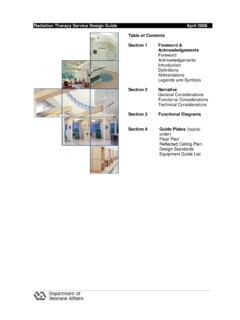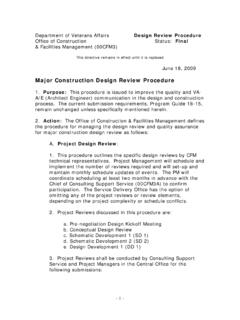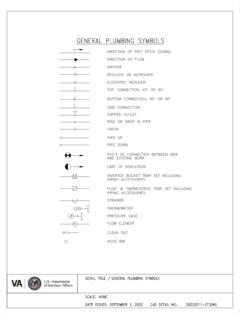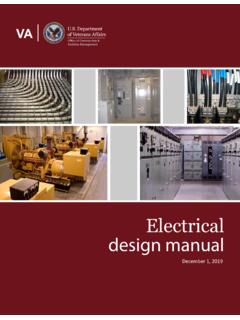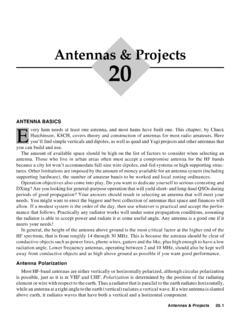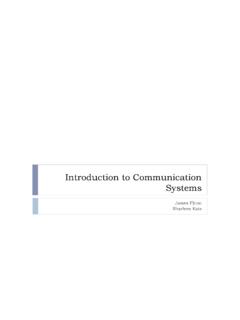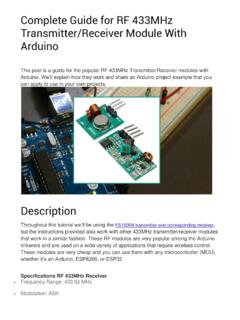Transcription of January 1, 2022 designmanual - Veterans Affairs
1 Lighting PG-18-10 January 1, 2022 designmanual TABLE OF CONTENTS 1 CHAPTER 1: GENERAL REQUIREMENTS PURPOSE RESPONSIBILITY AUTHORITY HAVING JURISDICTION (AHJ) COORDINATION PLANNING AND DESIGN INSTALLATION DESIGN STANDARDS AND CODES GENERAL VA STANDARDS OTHER STANDARDS AND CODES DAYLIGHTING GENERAL ABBREVIATIONS GLOSSARY CHAPTER 2: LIGHTING DESIGN REQUIREMENTS ENERGY CONSERVATION LIGHTING DESIGN STRATEGIES LIGHTING DESIGN OBJECTIVES INTERIOR EXTERIOR LIGHTING CONTROL DESIGN STRATEGIES AND OBJECTIVES LIGHTING CONTROL DESIGN METHODOLOGIES INTERIOR EXTERIOR LUMINAIRE SELECTION GUIDELINES INTERIOR EXTERIOR LIGHT SOURCE SELECTION GUIDELINES FLUORESCENT HIGH INTENSITY DISCHARGE (HID) LIGHT EMITTING DIODES (LED) BALLAST AND LED DRIVER SELECTION GUIDELINES FLUORESCENT BALLAST HID BALLAST LED DRIVER EMERGENCY POWER PACK SELECTION GUIDELINES TABLE OF CONTENTS 2 LIGHTING CONTROL SELECTION GUIDELINES LIGHTING CALCULATIONS LIGHTING SYSTEM COMMISSIONING LIGHTING MAINTENANCE CONSIDERATIONS CHAPTER 3.
2 EXTERIOR LIGHTING GUIDELINES ROADWAYS OPEN PARKING AREAS WALKWAYS ENTRIES LANDSCAPE BUILDING PERIMETER FLAGPOLES PARKING STRUCTURES HELICOPTER PADS WATER TANKS ROOF-MOUNTED antenna -OBSTRUCTION LIGHTS CHAPTER 4: PATIENT AREAS LIGHTING GUIDELINES PATIENT AREAS LIGHTING GUIDELINES MATRIX SPECIALTY, DIAGNOSTIC, AND TREATMENT AREAS EXAMINATION AND TREATMENT ROOM BLOOD DRAW STATION ORTHOTIC AND CASTING ROOM LABORATORY PROCEDURE ROOM DIAGNOSTIC IMAGING ROOM DIAGNOSTIC TESTING ROOM CHEMOTHERAPY TREATMENT ROOM RADIATION THERAPY ROOM DIALYSIS TREATMENT ROOM PHYSICAL/OCCUPATIONAL THERAPY AUDIOLOGY TESTING ROOM SURGERY/OPERATING ROOM SURGICAL CORRIDOR AND SCRUB AREA PRE-OPERATIVE AND POST-ANESTHETIC CARE (PACU) DENTAL EXAM AND TREATMENT ROOM TABLE OF CONTENTS 3 ORAL SURGERY, MINOR PROCEDURE ROOM PHARMACY PATIENT CARE AREAS NURSE STATION PATIENT CORRIDOR MEDICATION ROOM PATIENT ROOM, GENERAL PATIENT ROOM, ISOLATION PATIENT ROOM, INTENSIVE CARE PATIENT ROOM, RESIDENTIAL PATIENT TOILET/SHOWER PATIENT TOILET/SHOWER - RESIDENTIAL NOURISHMENT STATION DAY ROOM MULTI-PURPOSE ACTIVITY ROOM DRESSING ROOM MENTAL HEALTH (MH) PATIENT ROOM PATIENT TOILET CANTEEN DAY ROOM GROUP THERAPY ROOM NURSE STATION EXAMINATION AND TREATMENT ROOM RRTP: PATIENT ROOM RRTP: PATIENT TOILET/SHOWER RRTP: LIVING AREA, DINING AREA, AND KITCHENETTE RRTP: OUTPATIENT GROUP THERAPY ROOM CHAPTER 5.
3 PUBLIC AREAS MAIN LOBBY ELEVATOR LOBBY WAITING AREA PRIMARY CORRIDORS SECONDARY CORRIDORS CANTEEN TABLE OF CONTENTS 4 BARBER SHOP RECEPTION PUBLIC TOILET Veterans CANTEEN SERVICE AND GIFT STORE CHAPTER 6: ADMINISTRATIVE AREAS OFFICE CONFERENCE ROOM/CLASSROOM TEAM/BREAK ROOM STAFF TOILET AND LOCKERS CHAPTER 7: SUPPORT AREAS STORAGE HOUSEKEEPING SOILED UTILITY ROOM CLEAN UTILITY ROOM MAINTENANCE/REPAIR SHOPS STERILE PROCESSING AND LOGISTICS: CLEAN SIDE STERILE PROCESSING AND LOGISTICS: EQUIPMENT PREPARATION STERILE PROCESSING AND LOGISTICS: DETERGENT AND WATER ELECTRICAL AND MECHANICAL ROOMS EQUIPMENT ROOM LOADING DOCKS MAIL ROOMS APPENDIX A: ILLUMINATION LEVELS CHAPTER 1: GENERAL REQUIREMENTS 1. GENERAL REQUIREMENTS CHAPTER 1: GENERAL REQUIREMENTS GENERAL This manual is a guide for Architects, Engineers and Lighting Design Professionals (hereafter referred as A/E) for the planning and design of the lighting and lighting control systems (hereafter referred to as lighting systems, or systems) at the Department of Veterans Affairs (VA) facilities.
4 VA requires A/E to read, understand, and use this manual in the planning and design of the systems in all VA construction projects minor, major and non-recurring-maintenance (NRM). A/E - who provide planning and design of the systems - shall be licensed professionals who have engaged mainly in the specialized profession of lighting system design and all related duties of lighting system design. Lighting systems are dependent on electrical power for their function and operation. Therefore, this manual shall be used in conjunction with the VA Electrical Design Manual (EDM) to produce complete and functional systems. VA expects that the systems planned and designed with the use of this manual shall meet their primary objectives stated in Chapter 2. In order to provide the latitude needed to incorporate new technologies and concepts, or to accommodate adverse existing conditions, technical deviations from the stipulations of this manual may be made.
5 Deviations may be made only if a safe, reliable, functional and energy-efficient design shall result. Such deviations must be approved by VA s Project Team which consists of Contracting Officer (CO), Project Manager (PM), Contracting Officer Representative (COR), and Authority Having Jurisdiction (AHJ). Deviations are not permitted from those requirements included in shall comply with all public laws, federal regulations, executive orders, and applicable codes. Request for deviations shall be submitted in writing by A/E to CO and AHJ through PM or COR. At the minimum, request for deviations shall contain the following elements: Narrative detailing reasons for the deviations. Narrative detailing the design and technical information relating to the deviations. Design drawings of the deviations (if applicable).
6 Lighting and engineering calculations (if applicable). Estimate of cost impact caused by the deviations. Estimate of schedule impact caused by the deviations. Supporting documents such as existing site survey photographs, drawings and documents (if applicable). Request for deviations shall be considered approved only after A/E has received a written approval with signature from CO, and AHJ. RESPONSIBILITY A/E shall provide all necessary professional services to perform planning and design of the systems for the project. A/E shall be responsible and liable for the planning and design in accordance with the contract, professional engineering and design practices, latest VA standards and applicable codes, and project-specific requirements. CHAPTER 1: GENERAL REQUIREMENTS AUTHORITY HAVING JURISDICTION (AHJ) Authority Having Jurisdiction (AHJ) for VHA is the Deputy Undersecretary for Operations and Management (DUSHOM), or his/her designee.
7 Due to the nature of change in personnel and contact information in VA, AHJ and his/her contact information may not be constant. Therefore, A/E shall obtain AHJ s name and contact information from CO, PM or COR. COORDINATION PLANNING AND DESIGN A/E shall coordinate planning and design of the lighting systems with architectural, electrical, structural, civil, site utility and site work, HVAC, plumbing, fire protection/alarm systems, and sustainable designs, as applicable. A/E shall coordinate design information between construction drawings to ensure clarity, completeness and correctness in accordance with latest VA Standards and applicable codes, project-specific requirements, and pre-existing conditions (if any). A/E shall coordinate and edit applicable VA master specifications, and standard details to ensure clarity, completeness and correctness in accordance with latest VA Standards and applicable codes, project-specific requirements, and pre-existing conditions (if any).
8 For renovation projects, A/E shall perform site visit(s) to investigate, and document pre-existing conditions. Findings of pre-existing conditions shall be taken into account for the planning and design of the project. For exterior spaces, focus should be on coordination of hardscape, softscape, and landscape. Base designs for pole-mounted luminaires should be coordinated with civil and structural engineers. A/E shall reference VA base-mounting details and modify to meet specific project scope. Base-mounting details shall be shown on drawings. For interior spaces, focus should be on coordination of luminaire type, trim and layout with ceiling type, construction, layout, plenum depths, diffusers, ceiling tracks, and all ceiling-mounted objects. Luminaire layout should be coordinated with furniture, casework, millwork, and equipment layouts.
9 Lighting control device locations should be coordinated with interior features and furnishings to assure ready access, as well as proper sensor performance. INSTALLATION A/E is not responsible to provide (furnish, install, and connect) lighting systems. However, lighting design document shall show clear, complete and correct information regarding all aspects of lighting and electrical power designs. During the submittal review phase, A/E shall coordinate lighting equipment submittals with ceiling system submittals to ensure complete and correct coordination between lighting and ceiling systems. CHAPTER 1: GENERAL REQUIREMENTS For renovation projects, separate demolition drawings are required for all areas involved in the project. Specific information and design of interfaces between renovated and existing-to-remain conditions shall be clearly indicated on the drawings.
10 DESIGN STANDARDS AND CODES GENERAL At the minimum, comply with the latest Codes and Standards of the following organizations: (1) American National Standards Institute (ANSI) (2) ASTM International (ASTM) (3) Building Industry Consulting Service International, Inc. (BICSI) (4) Illuminating Engineering Society of North America (IESNA): A/E shall pay particular attention to latest edition of the following publications: Illuminating Engineering Society Handbook. RP-29 Lighting for Hospitals and Health Care Facilities RP-28 Lighting and the Visual Environment for Senior Living RP-33 Lighting for Exterior Environments RP-20 Lighting for Parking Facilities RP-8 Roadway Lighting DG-10 Choosing Light Sources for General Lighting G-1 Guidelines on Security Lighting for People, Property and Public G-2 Guidelines for Application of General Illumination - LED Technologies (5) Institute of Electrical and Electronic Engineers (IEEE) (6) National Fire Protection Association (NFPA) (7) National Electrical Manufacturers Association (NEMA) (8) Underwriters Laboratories, Inc.
